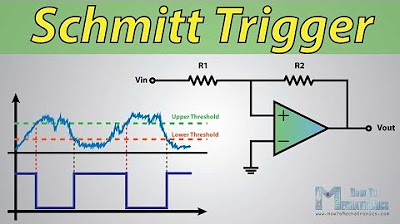What is Hall Effect and How Hall Effect Sensors Work
Summary
TLDRIn this educational video from howtomechatronics.com, Dan Luksky explains the Hall effect and its application in sensors. The Hall effect, discovered by Edwin Hall in 1879, is a phenomenon where a voltage is generated across a conductor when a magnetic field is applied perpendicular to the current flow. Hall effect sensors, which are prevalent in modern technology, are used in various applications such as wheel speed sensors in vehicles, MEMS compasses, and proximity sensors. The video delves into the working principles of these sensors, highlighting the differences between analog and digital output sensors, and their specific uses in measuring magnetic fields and detecting positions in mechanical systems.
Takeaways
- 🧲 The Hall effect is a method for measuring magnetic fields discovered by Edwin Hall in 1879.
- 🚗 Hall effect sensors are widely used in vehicles for wheel speed sensing, and as position sensors for crankshafts or camshafts.
- 🔧 They are also utilized as switches, MEMS compasses, and proximity sensors in various applications.
- 🔬 The experiment in the video demonstrates how a magnetic field disturbs the flow of charge carriers in a conductive plate, resulting in a measurable voltage.
- 📊 Hall effect sensors typically provide a small voltage output, requiring built-in high gain amplifiers.
- 📡 There are two types of Hall effect sensors: analog, which offers a continuous output, and digital, which provides binary on/off outputs.
- 🔌 The analog sensor consists of a voltage regulator, Hall element, and amplifier, suitable for measuring proximity.
- 🛠️ Digital output sensors include a Schmitt trigger for hysteresis, useful in applications like limit switches in 3D printers and CNC machines.
- 🔄 Hall effect switches are used for detection and positioning in industrial automation systems.
- ⚙️ For measuring wheel speed or engine component positions, sensors use a Hall element and a permanent magnet near a toothed disk on a rotating shaft.
Q & A
What is the Hall effect?
-The Hall effect is a phenomenon where a measurable voltage is generated across a thin conductive plate when a magnetic field is applied perpendicular to the current flow. This effect was discovered by Edwin Hall in 1879.
How do Hall effect sensors measure magnetic fields?
-Hall effect sensors measure magnetic fields by detecting the deflection of charge carriers within a conductive material due to the Lorentz force when a magnetic field is present. This deflection creates a voltage difference across the material, which is proportional to the strength of the magnetic field.
What are some contemporary applications of Hall effect sensors?
-Hall effect sensors are used in various applications such as wheel speed sensors in vehicles, position sensors for crankshaft or camshaft, switches, MEMS compasses, proximity sensors, and in industrial automation systems for detection and positioning.
How do Hall effect sensors work in vehicles?
-In vehicles, Hall effect sensors are used as wheel speed sensors, crankshaft or camshaft position sensors. They provide accurate measurements of speed and position by detecting changes in the magnetic field as a toothed wheel or disk rotates.
What is the difference between analog and digital Hall effect sensors?
-Analog Hall effect sensors provide a continuous output proportional to the magnetic field strength, suitable for measuring proximity. Digital Hall effect sensors have two output states (on or off), often used as switches, with an additional Schmitt trigger for hysteresis and threshold levels.
Why do Hall effect magnetic sensors typically require a built-in amplifier?
-Hall effect magnetic sensors typically provide very small voltages, only a few microvolts per gauss, which are not sufficient for most applications. Therefore, they are usually manufactured with built-in high gain amplifiers to boost the signal to a usable level.
What is a Schmitt trigger and how does it relate to Hall effect sensors?
-A Schmitt trigger is an electronic circuit that provides hysteresis, allowing for two different threshold levels. In Hall effect sensors, it is used to ensure a clean switching between the on and off states, making it suitable for applications like switches and limit sensors.
How are Hall effect sensors used for measuring wheel speed or RPM?
-Hall effect sensors measure wheel speed or RPM by detecting the passing of teeth on a toothed disk attached to the rotating shaft. Each tooth passing near the sensor changes the magnetic field, causing the sensor output to switch states, generating a square wave signal that can be counted to calculate RPM.
What is the role of the tooth disk in Hall effect sensor applications?
-The tooth disk in Hall effect sensor applications is attached to the rotating shaft and has a small gap with the sensor. As the teeth pass by the sensor, they alter the magnetic field, causing the sensor to output a high or low signal, which can be used to determine position or speed.
Can you provide an example of a contemporary application of Hall effect sensors in industrial automation?
-In industrial automation, Hall effect sensors are used for detection and positioning, such as in 3D printers and CNC machines, where they act as limit switches or for precise control of mechanical movements.
Outlines

このセクションは有料ユーザー限定です。 アクセスするには、アップグレードをお願いします。
今すぐアップグレードMindmap

このセクションは有料ユーザー限定です。 アクセスするには、アップグレードをお願いします。
今すぐアップグレードKeywords

このセクションは有料ユーザー限定です。 アクセスするには、アップグレードをお願いします。
今すぐアップグレードHighlights

このセクションは有料ユーザー限定です。 アクセスするには、アップグレードをお願いします。
今すぐアップグレードTranscripts

このセクションは有料ユーザー限定です。 アクセスするには、アップグレードをお願いします。
今すぐアップグレード関連動画をさらに表示

What Is Schmitt Trigger and How It Works

Materi Inisiasi 1, MK. Kawasan Teknologi Pendidikan

CABE (Central Advisory Body of Education) |For M.Ed (Institutional Planning and Management)| By Anil

Komponen-komponen pengembangan kurikulum (Dr. Laksmi Dewi, M.Pd.)

PENGERTIAN, MODEL, DAN STRATEGI INOVASI PENDIDIKAN

Education Inequality

O QUE É URBANIZAÇÃO? RESUMO E CONCEITOS | QUER QUE DESENHE?
5.0 / 5 (0 votes)
